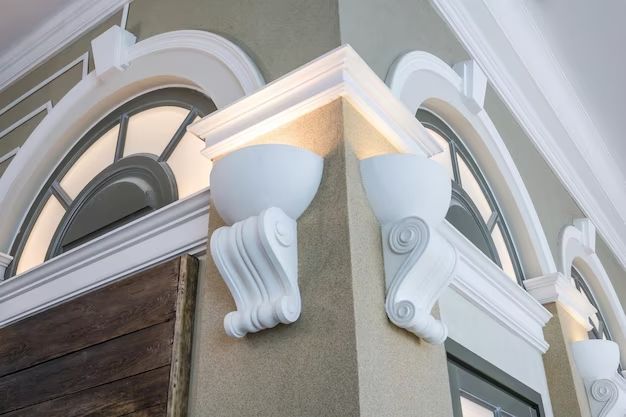Exterior crown molding installed on the outside of a home or building is typically referred to as “exterior crown molding”. It serves both decorative and functional purposes, adding visual interest while also protecting the transition between walls and roof lines from water damage.
Page Contents
Types of Exterior Crown Molding
There are a few main types of exterior crown molding:
- Wood – Typically made of cedar or pine. Durable and can be painted or stained.
- Polyurethane – A versatile plastic material that can be molded into various shapes. Low maintenance.
- Fiber cement – Made of cement, sand, and cellulose fibers. Rot-resistant and long-lasting.
- Foam – An inexpensive option made of expanded polystyrene. Can be carved and painted.
Names for Specific Exterior Crown Molding Styles
Some specific styles of exterior crown molding have particular names:
- Bed molding – A simple rectangular crown molding, often used on Craftsman style homes.
- Cove molding – Has a concave curved shape cut into the bottom. Creates strong shadow lines.
- Egg and Dart – Features egg-shaped ornaments alternating with triangular darts. Classic decorative look.
- Ogee – An S-shaped curve with one concave and one convex side. Provides elegance and flair.
Benefits of Adding Exterior Crown Molding
There are several advantages to installing crown molding on the exterior of a home:
- Aesthetics – Crown molding adds visual appeal, depth, and architectural interest.
- Protection – It helps protect walls from moisture damage caused by rain.
- Increased home value – Crown molding boosts curb appeal, potentially increasing a home’s resale value.
- Hides flaws – It can conceal uneven transitions between surfaces.
- Versatility – Many styles are available to match a home’s design aesthetic.
Installation Tips
Proper installation is key to getting the most out of exterior crown molding. Here are some helpful tips:
- Carefully measure the area to calculate the exact length of molding needed.
- Check all surfaces for level and plumb. Shims may be needed to create an even base.
- Pre-drill molding pieces before nailing to avoid splitting the wood.
- Allow space between molding joints for expansion and contraction.
- Caulk and paint for waterproofing and an optimal finished look.
Cost Considerations
The cost of exterior crown molding depends on several factors:
- Molding material – Synthetic options like foam are cheapest while real wood is more expensive.
- Molding style – Intricate, highly decorative styles cost more than simple shapes.
- Labor – Hiring a professional contractor will add cost but save time and effort.
- Amount needed – The total linear footage around the home impacts overall price.
- Accessibility – Multi-story installations are generally more labor intensive.
On average, exterior crown molding costs $6-$12 per linear foot installed. A typical 2500 square foot home costs $3000-$5000 to add molding.
Conclusion
Exterior crown molding provides an attractive finishing touch to a home’s roofline while also serving important protective functions. From classic ogee to bold cove designs, many molding options exist to suit any architectural style. With proper planning and installation, exterior crown molding can be an outstanding investment, boosting curb appeal and creating a gracefully finished exterior.
